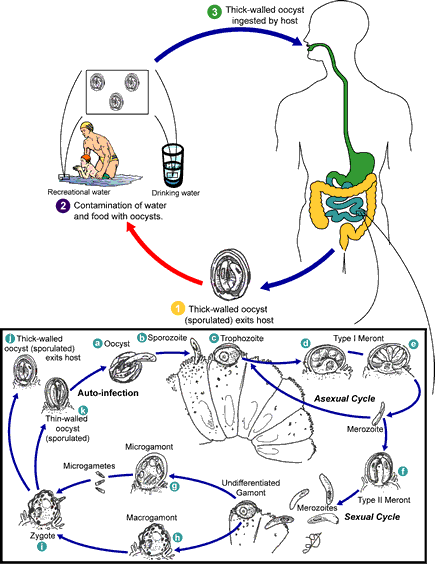| |
Sporulated oocysts,
containing 4 sporozoites, are excreted by the infected host through feces
and possibly other routes such as respiratory secretions
 .
Transmission of Cryptosporidium parvum and C. hominis occurs
mainly through contact with contaminated water (e.g., drinking or
recreational water). Occasionally food sources, such as chicken salad, may
serve as vehicles for transmission. Many outbreaks in the United States
have occurred in waterparks, community swimming pools, and day care
centers. Zoonotic and anthroponotic transmission of C. parvum and
anthroponotic transmission of C. hominis occur through exposure to
infected animals or exposure to water contaminated by feces of infected
animals .
Transmission of Cryptosporidium parvum and C. hominis occurs
mainly through contact with contaminated water (e.g., drinking or
recreational water). Occasionally food sources, such as chicken salad, may
serve as vehicles for transmission. Many outbreaks in the United States
have occurred in waterparks, community swimming pools, and day care
centers. Zoonotic and anthroponotic transmission of C. parvum and
anthroponotic transmission of C. hominis occur through exposure to
infected animals or exposure to water contaminated by feces of infected
animals  .
Following ingestion (and possibly inhalation) by a suitable host .
Following ingestion (and possibly inhalation) by a suitable host
 ,
excystation ,
excystation
 occurs. The sporozoites are released and parasitize epithelial cells (
occurs. The sporozoites are released and parasitize epithelial cells ( , ,
 )
of the gastrointestinal tract or other tissues such as the respiratory
tract. In these cells, the parasites undergo asexual multiplication (schizogony
or merogony) ( )
of the gastrointestinal tract or other tissues such as the respiratory
tract. In these cells, the parasites undergo asexual multiplication (schizogony
or merogony) ( , ,
 , ,
 )
and then sexual multiplication (gametogony) producing microgamonts (male) )
and then sexual multiplication (gametogony) producing microgamonts (male)
 and macrogamonts (female)
and macrogamonts (female)
 .
Upon fertilization of the macrogamonts by the microgametes ( .
Upon fertilization of the macrogamonts by the microgametes ( ),
oocysts ( ),
oocysts ( , ,
 )
develop that sporulate in the infected host. Two different types of oocysts
are produced, the thick-walled, which is commonly excreted from the host )
develop that sporulate in the infected host. Two different types of oocysts
are produced, the thick-walled, which is commonly excreted from the host
 ,
and the thin-walled oocyst ,
and the thin-walled oocyst
 ,
which is primarily involved in autoinfection. Oocysts are infective upon
excretion, thus permitting direct and immediate fecal-oral transmission. ,
which is primarily involved in autoinfection. Oocysts are infective upon
excretion, thus permitting direct and immediate fecal-oral transmission.
Note that oocysts of Cyclospora cayetanensis, another important
coccidian parasite, are unsporulated at the time of excretion and do not
become infective until sporulation is completed. Refer to the life cycle of
Cyclospora cayentanensis for further details. |
|
